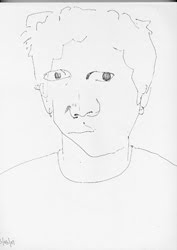From March 1st to April 30th I will be Artist-in-residence at the Boston Center for the Arts. It's the first residency that they've hosted and it will serve as a pilot for the program. My work during this time, "The Personal Form of the City," will focus on the activity of mapping my personal experience in Boston and will involve my drawing a map of Boston from memory.
Everyone who lives in the city inhabits the same physical environment but no two people use it in the same way. Our use of the city informs our mental landscape and so everyone's personal city is shaped differently. It's difficult to describe what you don't know so I'm hoping to use drawing as a method to tap into my unconscious use of the world.
As a part of the project, I will be hosting three drawing/mapping workshops. These workshops are free and open to the public. Participants will map their neighborhoods, commutes and daily lives in the city and through the act of drawing will learn about the way they each experience the city. I'll be incorporating the maps from these workshops into my larger maps of the city. These will be two-hour workshops and no drawing experience is necessary. Ages 13 and up.
March 16, 2010 4-6pm
April 13, 2010 4-6pm
April 28, 2010 4-6pm
Workshops are limited to 20 participants.
Please pre-register by March 9th for the March 16th workshop,
contact Cynthia Woo at cwoo [at] bcaonline [dot] org, or 617.426.1119.
They're also posted here: Boston Center for the Arts
Sunday, February 28, 2010
Tuesday, February 16, 2010
The Music of Iran - a guest post on Radio diffusion blog
I wrote this little essay for the mighty music blog radiodiffusion, curated by the gentleman behind, among other things, the Sublime Frequencies compilation of Indian steel guitar soundtrack music called Bollywood Steel Guitar. If you haven't been there before, it's worth thumbing through his vast collection of obscure records from all over the world. My little post, with mp3, can be found here, or you can read the text below. You can view cover scans of most of my Iranian records here:
Information on the popular music of pre-revolutionary Iran is hard to come by if you don’t read Farsi. Most reissues of the music are in Farsi and have little to no liner notes, save for Göhkan Aya’s well researched essay for the Raks Raks Raks compilation released last year on Raks Discos. This is perhaps due in part to the political situation surrounding the music and culture, much of what was recorded prior to the 1978 revolution became illegal with the new regime and was destroyed when found by the police. Performers who had substantial careers prior to the revolution had to flee the country or risk persecution as even the simple act of a woman performing as a soloist became illegal, not to mention the performance of westernized Persian music that had become increasingly popular under the last years of the Shah. Records that you find now from that period in Iran have likely survived many hardships and they almost always show it in one way or another.
Stuart has already covered much of the cultural history of Iran in his previous posts so I’ll leave that for now and say that this track from the singer Pouran. She began singing in 1951 at the age of 18, using the stage name of “Unknown Lady” or “Lady Anonymous Singer, ” depending on how you translate the Farsi. She married her vocal instructor, violinist Abbas Shapouri, and altered her stage name first to “Lady Shapouri, ” then to the simpler “Pouran, ” collaborating with Shapouri for the duration of their seven-year marriage to produce some of her most popular songs. At the height of her career, she was well regarded as an actress and singer, possibly recording as many as 2000 songs, although that’s really an impossible number to confirm. After her divorce, she continued to perform and record, often appearing on Iranian National Radio, until the late 70’s, when the revolution forced her to stop performing and flee the country. She died in 1991 during a visit to Iran and is buried in the Imamzadeh Taaher cemetery in the city of Karaj.
As an example of the difficulty in finding information on this era of recorded music, this line from the Google translation of her Wikipedia page jumped out at me: “Art said his toe in Salt Lady nephew heartsome other is born of that era” in reference to her musical association with her first husband.
Without much of a discography available, I’d guess that this record is from the later part of her career. It’s released on Ahang Rooz, the first and largest of pre-revolutionary Iranian record labels, and has the analog synthesizer sound that seems to have enjoyed some popularity in the later 70’s. The single includes the two songs: “Shahr-e Paeez” (The City of Autumn) and “Ye Roozam Maa Ra Faramoosh Mikoni” (One Day You Will Forget Me).
Thanks to Hamineh, Kourosh and Ramin for their help on this post as well as for all the other information that they’ve helped me with. Any factual errors or misunderstandings are mine.
Catalog number AR-2519 on Ahang Rooz of Iran. No release date listed.
http://radiodiffusion.wordpress.com/2010/02/07/pouran/
Subscribe to:
Posts (Atom)
